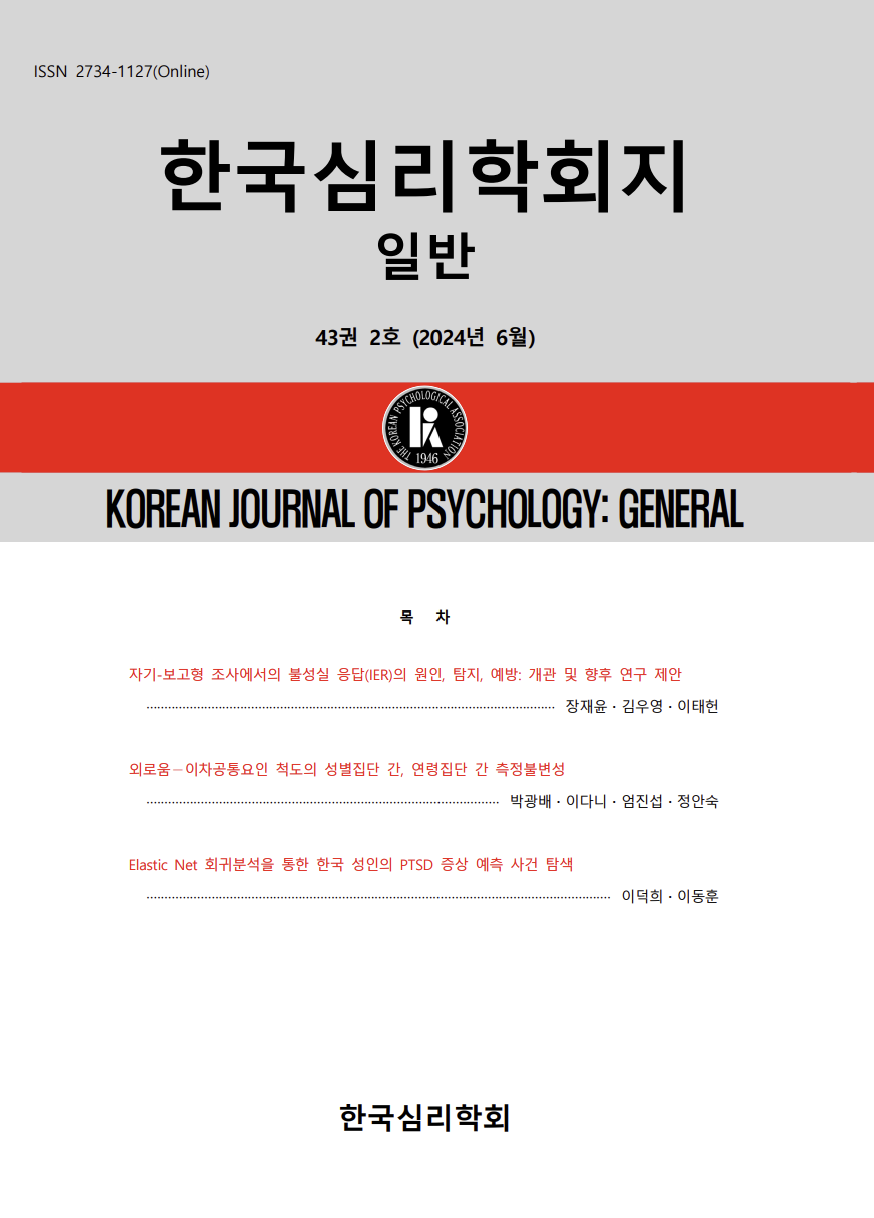- ENGLISH
- P-ISSN1229-067X
- E-ISSN2734-1127
- KCI
 ISSN : 1229-067X
ISSN : 1229-067X
논문 상세
- 2025 (44권)
- 2024 (43권)
- 2023 (42권)
- 2022 (41권)
- 2021 (40권)
- 2020 (39권)
- 2019 (38권)
- 2018 (37권)
- 2017 (36권)
- 2016 (35권)
- 2015 (34권)
- 2014 (33권)
- 2013 (32권)
- 2012 (31권)
- 2011 (30권)
- 2010 (29권)
- 2009 (28권)
- 2008 (27권)
- 2007 (26권)
- 2006 (25권)
- 2005 (24권)
- 2004 (23권)
- 2003 (22권)
- 2002 (21권)
- 2001 (20권)
- 2000 (19권)
- 1999 (18권)
- 1998 (17권)
- 1997 (16권)
- 1996 (15권)
- 1995 (14권)
- 1994 (13권)
- 1993 (12권)
- 1992 (11권)
- 1991 (10권)
- 1990 (9권)
- 1989 (8권)
- 1988 (7권)
- 1987 (6권)
- 1986 (5권)
- 1985 (5권)
- 1984 (4권)
- 1983 (4권)
- 1982 (3권)
- 1981 (3권)
- 1980 (3권)
- 1979 (2권)
- 1976 (2권)
- 1974 (2권)
- 1971 (1권)
- 1970 (1권)
- 1969 (1권)
- 1968 (1권)
코로나 시기 한국 성인의 직무소진 변화궤적 분석: 잠재계층성장분석(LCGA)을 이용한 종단연구
Trajectories of Job Burnout Among Korean Adults During the COVID-19 Pandemic: A Longitudinal Study Using Latent Growth Analysis (LCGA)
김예진(Shi Hyeong Kim) (성균관대학교)
정다송(Dasong Jung) (성균관대학교)
이동훈(Dong Hun Lee) (성균관대학교)

- dhlawrence05@gmail.com
초록
본 연구에서는 코로나 시기 동안 국내 성인의 직무소진 변화 궤적에 따른 잠재집단을 확인한 후 변화유형에 영향을 미치는 예측요인을 살펴보고, 각 유형별 삶의만족과 외로움의 차이를 확인하고자 하였다. 이를 위해 본 연구에서는 2021년 2월부터 2022년 8월까지 8개월 간격으로 수집된 국내 성인 381명의 세 시점 자료를 활용하여 직무소진의 변화를 유형화하는 잠재계층성장분석을 실시하였다. 분석결과, 최종 4개의 집단이 가장 적절한 것으로 나타났으며, 변화양상에 따라 각각의 집단을 ‘회복집단(집단1)’, ‘지연소진집단(집단2)’, ‘탄력성집단(집단3)’, ‘만성소진집단(집단4)’으로 명명하였다. 직무소진의 발달궤적 변화유형에 영향요인을 확인한 결과, 높은 연령은 지연소진집단과 탄력성집단에, 여성 성별과 높은 경제적 수준은 탄력성집단에 속할 확률이 높은 것으로 나타났다. 마지막으로 직무소진의 변화유형에 따른 삶의만족과 외로움의 차이를 확인한 결과, 모든 조사시기에 탄력성집단이 높은 삶의만족 수준을 보이는 것으로 나타났다. 또한 외로움의 경우, 시점 간 차이는 있었지만 전반적으로 지연소진집단, 회복집단, 탄력성집단 순으로 외로움이 높게 나타났다. 본 연구결과는 향후 전염병 상황에서 국내 성인의 정신건강 향상을 위한 기초적인 자료와 정책적 대안을 모색하는 근거로 활용될 수 있을 것이다.
- keywords
- 코로나 대유행, 직무소진, 삶의만족, 외로움, 잠재계층성장모형
Abstract
This study tried to identify potential groups according to the trajectory of job burnout changes in adults during the COVID-19 period, examine predictive factors affecting the type of change, and identify differences in life satisfaction and loneliness for each type. To this end, a latent class growth analysis was conducted on 381 adults during the COVID-19 pandemic to categorize changes in job burnout. As a result of the analysis, the final four groups were found to be the most appropriate, and each group was named ‘recovery group’, ‘delayed burnout group’, ‘resilience group’, and ‘chronic burnout group’ according to the pattern of change. As a result of examining the influence factors on the type of change in the development trajectory of job burnout, it was found that older people are more likely to belong to delayed burnout groups and resilience group, and women’s gender and high economic levels are more likely to belong to elastic groups. Finally, examining the differences in life satisfaction and loneliness across job burnout change types showed that elastic groups consistently reported high life satisfaction in all survey periods. In addition, in the case of loneliness, there was a difference between points of time, but overall loneliness was high in the order of delayed burnout, recovery, and resilience group. The results of this study can be used as ac basis for seeking basic data and policy alternatives to improve mental health of adults in Korea in future infectious disease situations.
- keywords
- COVID-19 pandemic, job burnout, life satisfaction, loneliness, latent class growth model
- 투고일Submission Date
- 2024-05-14
- 수정일Revised Date
- 2024-10-11
- 게재확정일Accepted Date
- 2024-12-24
- 98다운로드 수
- 122조회수
- 0KCI 피인용수
- 0WOS 피인용수

